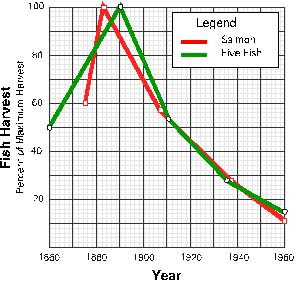|
|
Some
Highlights from Saving Salmon
The current effort to save the salmon is concentrating on the river
physical habitat, (i.e., riparian zones, water temperature, condition
of the river bottom, rip-rap, culverts, obstructions, etc.). Simply
stated, the survival of any species depends on three factors: food,
predators and physical habitat. Physical habitat is about 30 percent
of the problem. Salmon spends 2/3 of his time in the ocean, thus
the ocean represents about 20 % of the total problem and the remaining
10 % is divided between the rivers and the estuaries. See the figure
top right. Therefore, the river physical habitat represents about
5% of the problem. The probability of successfully solving a problem
by working on only 5% of the problem alone is exceeding low.
By counting
the relative abundance of sardine, anchovy, hake, saury, and mackerel
scales at different depths in these ocean sediments and comparing
them to present stocks, estimates of past abundance of these five
fish can be determined over the last 200 years. It is interesting
to compare this data with the historic Columbia River salmon catch
data. See the curves bottom right. The red curve is the Columbia
River Salmon catch data and the green curve is plot based on the
fish scale abundance. The duration and similarity of the population
trends exclude coincidence as a possible
|


|
explanation.
They are definitely linked and what caused the decline in one most
likely caused the decline in the other. Possible connections might
be:
> The six
species have a common food source that is declining,
> The six species have a common predator that is on the increase,
> All of the above.
Studies on 23
tributaries to the Columbia River show that popular human conceptions
of proper river habitat are not the same as the salmon‘s conception
of proper river habitat. Streams with “poor” and “bad”
habitat are outproducing streams with “good” habitat.
What humans consider as excellent stream habitat is available, but
is not being used by salmon.
We have been
using incomplete science to save the salmon for 100 years; maybe
we should begin to listen to the Salmon. To learn more download
the full sixty-two page report. |

